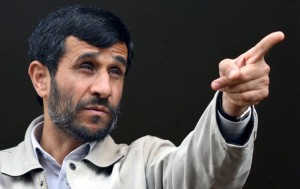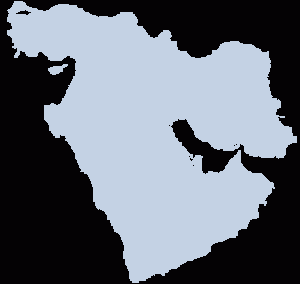Monday
Mar222010
Iran Analysis: Politics and Subsidy Reform (Harris)
 Monday, March 22, 2010 at 13:26
Monday, March 22, 2010 at 13:26  Kevan Harris writes in Middle East Report:
Kevan Harris writes in Middle East Report:Although most Iranians forget it today, Mahmoud Ahmadinejad was elected in 2005 on a platform of technocratic competence. The clique surrounding his rise to mayor of Tehran and beyond once called themselves Abadgaran, “the Developers.” In a column four months after Ahmadinejad’s election to the Iranian presidency, commentator Saeed Laylaz reminded readers of the sage advice of Deng Xiaoping, arguing that a hard-line conservative government could push through economic reforms where the reformist administration had failed. “The cat is finally catching mice,” Laylaz wrote, “and its color no longer matters.” After the exhaustion of the reform movement’s momentum, Ahmadinejad presented himself to the people as the intrepid engineering professor, the humble, principled and no-nonsense expert who could get things done. “Expert,” in fact, is one of the good doctor’s favorite words.
What occurred was instead second-rate. The network of clients enveloping the new president set its sights on capturing the money and resources controlled by the ossifying bureaucracy of the Islamic Republic. Abadgaran men and assorted hangers-on replaced the aging first generation of post-revolutionary technocratic cadres. No sweet plum remained unpicked in the state agencies and ministries, not even in provincial offices and the development projects they oversaw. The rebellious tone with which this turnover was presented—“throw the bums out”—resonated with the lower social strata, who have rarely benefited from state largesse.
In 2007, the president stuck a pitchfork of his own in the 60-year old Planning and Budget Organization, taking away its independent auditing power. But overall the Ahmadinejad administration has not exactly been distinguished by fiscal discipline and managerial efficiency. Ahmadinejad, for instance, has paid three rounds of highly publicized visits to the oft-neglected provinces. On his tours, he has been met with hundreds of thousands of handwritten letters asking for small favors—resolving a quarrel with a local official, helping a son lacking sufficient connections for a state post, defraying the cost of an upcoming wedding or paying an overdue bill. The supplicants received personalized replies, and a few dozen thousand-toman notes (1,000 tomans equal $1) were stuffed into the envelopes for good measure. Ahmadinejad’s political vehicle was nothing less than a new patronage machine. It is an administration charismatic in appearance, but inconsistent in policy and practice.
In the spring of 2010, with the country still in political tumult over the dubious election of the previous June, and in economic pain due to global recession, the reinstalled engineer-president announced a plan that drew out critics of his competence in droves. The government proposed to enact the most sweeping economic policy change in over a decade: a phasing out of price subsidies for nearly all staple commodities—bread, electricity, water and gasoline—starting in March and continuing until 2015, when they would cease entirely. The plan provoked immediate protest and predictions of chaos, prompting parliamentarians to chop half of the cuts out of the budget bill they passed on March 9
Easy Money No More
Ahmadinejad’s political opponents within the Islamic Republic, from reformists to pragmatic conservatives, and irrespective of their feelings about the Green Movement arising after the June election, were pleased to see the president on the economic hot seat at last. After 15 years of attempting to construct their own versions of a modernization project, they were aghast that this upstart had labeled them as the backward, out-of-touch cronies of an old elite. Whether they had sought to do so through a glasnost-style opening, like former President Mohammad Khatami, or through a top-down economic restructuring, like Khatami’s predecessor Akbar Hashemi-Rafsanjani, they had been equally disparaged. Infuriating them more was that Ahmadinejad liberally stole from their policy playbook, just as President Bill Clinton was etched into the pages of US history though the use of softened Republican Party talking points. Politically, the Islamic Republic’s bêtes noires in the Bush administration gave the Iranian regime easy targets with which to justify their position: a region in conflagration and blatant enforcement of double standards in nuclear geopolitics.
For most of Ahmadinejad’s first term, the money poured in, in the form of oil rents inflated due to the same regional crises. The government rode the heady boom in land prices and resplendent construction projects. In 2006–2007, many Iranians with capital jumped into the housing market, seeing dizzy gains of 100 percent every year. The resulting real estate bubble temporarily concealed the lack of a coherent development policy. The benchmarks and proposals of the Fourth Five-Year Plan (2005–2009), passed in Khatami’s era, were discarded in favor of hundreds of bridges to nowhere, and most of these were not even completed. The economy entered a liquidity trap, where over-accumulation of capital and a lack of profitable outlets for investment drove down the rate of return while sending prices into an upward spiral. Finally, Iran’s central bank reined in the easy money in mid-2008, months before the collapse of global financial markets (with much resistance from the president, who forced the two largest state banks to continue to hand out loans, resulting in the large debt burdens of today, as borrowers default). Each block of every middle-class neighborhood in Tehran is now home to three or four real estate offices, all filled with jacketed agents listlessly huddled together.
The economic hangover allowed political competitors to pin the label of ineptitude on the president’s dwindling faction and make it stick. If any theme permeated the televised debates between presidential candidates before the June 2009 election, it was competent governance. The intra-elite bickering was so intense that it arguably burned through the electorate’s apathy and ignited mass participation in the balloting.
Into this environment the President introduced his subsidy reform law, whose provisions were as follows: The government spent around 40 percent of its 2006 budget ($40 billion) on such subsidies and even more during 2008’s oil price peak. Of the revenue gained from the lessening of subsidy levels, the state would keep 20 percent, ostensibly compensating for increased costs in the public sector. Another 30 percent would be allocated to industries that rely heavily on subsidies and development of more energy-efficient infrastructure. The remaining 50 percent would be given back to Iranians in direct cash transfers or indirect welfare benefits, “targeting” the poorest strata of the population. After five years, the prices of the staples were to be close to regional market levels. The parliament wrote into the law that the government should gain no less than $10 billion and no more than $20 billion during the first year, which would have meant increasing prices for subsidized goods on average between 2.5 and 4 times their current levels.
Debate over the law was heated, even a bit melodramatic, with parties for and against seeming to believe equally in the awesome power of unregulated markets. The president identified this single reform as the solution to the country’s many economic, social and perhaps even cultural woes. On March 9, amid reports that Parliament would approve only half of the cuts, state news agencies relayed that Ahmadinejad was praying in the chamber for passage of them all. Critics of the law, including stalwart conservatives in Parliament, predicted hyperinflationary catastrophe and industrial collapse. Green Movement supporters hoped that an intensification of economic grievances would keep middle-class Iranians, some of whom see the plan as a government attack upon their livelihoods, coming into the streets. Labor activists foresaw a new surge of working-class unrest to fuel the Green fire.
The drama of the subsidy debate was all the higher for playing out against the backdrop of the post-election turmoil and the fragmentation of the political elite into so many temporary chiefdoms, with the accompanying fleeting wars and alliances. In this climate, no policy initiative on the scale of subsidy reform would proceed without the express approval of Ahmadinejad’s patrons, Supreme Leader Ayatollah Ali Khamenei and the Revolutionary Guards. Why, given the hubbub, did they permit the president to move forward with the subsidy-cutting plan? Have they gone nuts?
Read rest of article....



